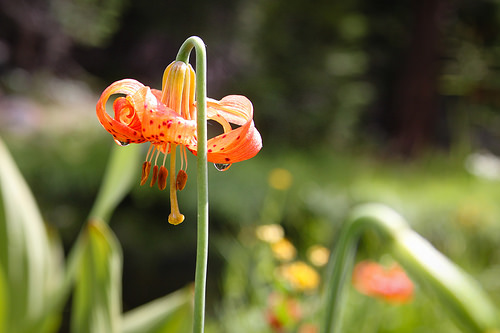Leopard lilies are on the prowl.
- A leopard lily is a species of perennial flowering plant, native to China, Japan and India in central Asia.
- ‘Leopard lilies’ are also known as ‘blackberry lilies’ and ‘leopard flowers’, and the plants have green sword-like leaves, that grow in a fan formation.
- The scientific name of the leopard lily is Iris domestica and it is from the family Iridaceae, the family of irises, though it was formerly known as Belamcanda chinensis.
- The height of a leopard lily plant can reach from 60 to 90 centimetres (2 to 3 feet) and a clump can spread out to 22 to 60 centimetres (0.75 to 2 feet) in diameter.
- Leopard lilies have showy flowers that are coloured yellow, orange or red, or often a combination of those colours, and they have red or dark orange spots.
Leopard Lily
Image courtesy of Odonata98/Flickr
- The seeds that form after a leopard lily blooms, have the appearance of blackberries, as the glossy black seeds grow together in a cluster.
- Leopard lilies grow best in conditions where there is full sun, and soil that is well drained.
- Leopard lily plants grow from rhizomes, and these have been used in traditional Chinese medicine to treat asthma, malaria and swelling, among other health issues.
- Leopard lilies bloom in the summer months, and the flowers are around 5 centimetres (2 inches) in diameter, with six petals.
- Leopard lilies are commonly used for ornamental purposes in the garden, and the seed stems and flowers are sometimes used decoratively as dried or fresh cut flowers.
Bibliography:
Iris Domestica, 2014, Some Magnetic Island Plants, http://www.somemagneticislandplants.com.au/index.php/plants/518-iris-domestica
Iris Domestica, 2016, Wikipedia, https://en.wikipedia.org/wiki/Iris_domestica
Iris Domestica, n.d, Missouri Botanical Garden, http://www.missouribotanicalgarden.org/PlantFinder/PlantFinderDetails.aspx?kempercode=b690







